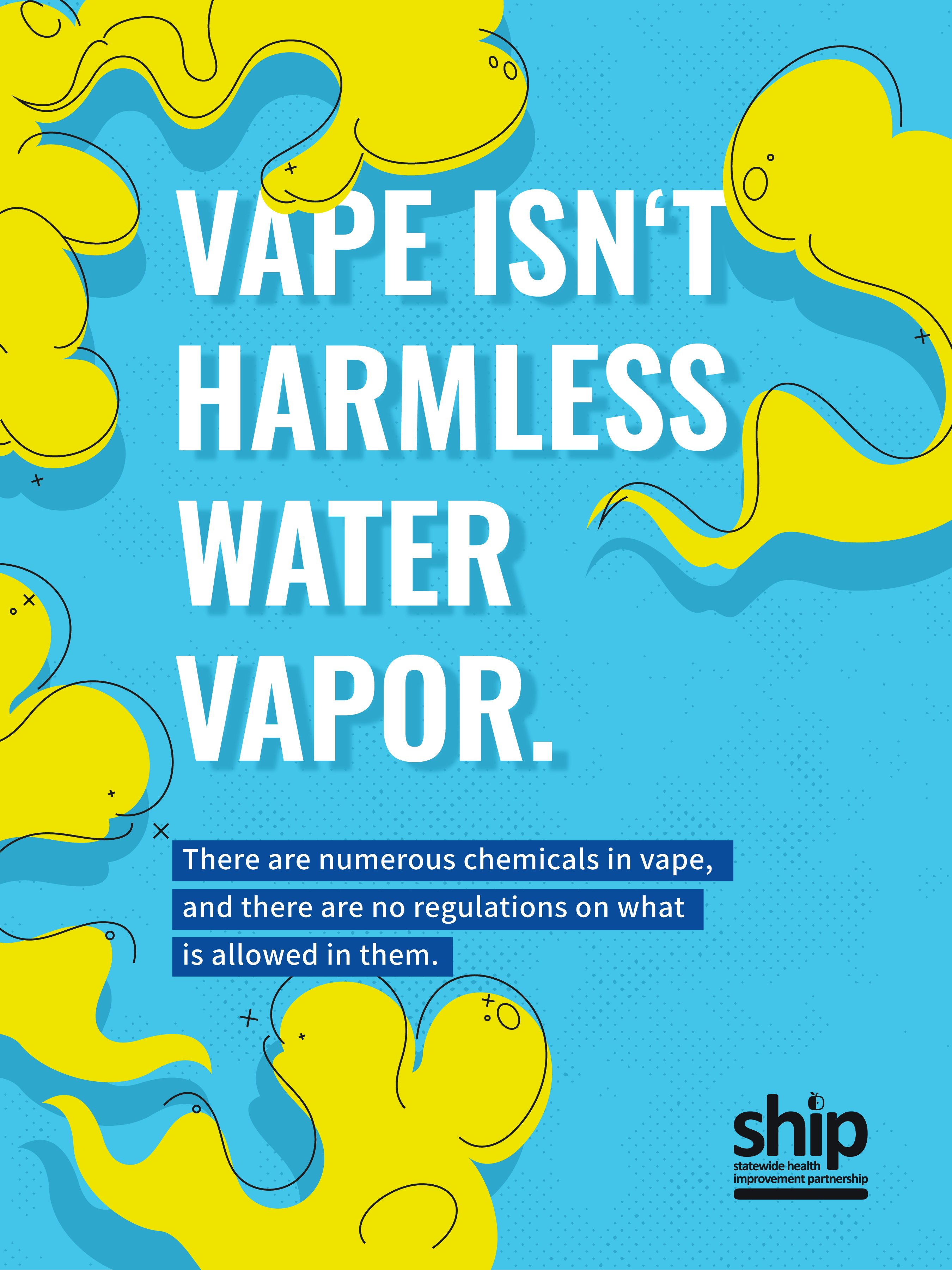School E-cigarette Toolkit
- Toolkit Home
- Implement Curriculum
- Help Students, Staff, and Parents Quit
- Review and Strengthen Policy
- Engage and Raise Awareness
Tobacco Topics
- Behavioral Health
- E-cigarettes and Vapes
- E-cigarette School Toolkit
- Flavored Tobacco
- Menthol Tobacco
- Nicotine
- Quitting Tobacco
- Helping People Quit
- Secondhand Smoke
- Tobacco 21
- Tobacco Taxes
- Traditional Tobacco
Related Topics
Contact Info
Engage and Raise Awareness about E-cigarettes
 Engage students, faculty and staff, and parents to ensure they have the information they need to comply with policies and support commercial tobacco prevention work for your school.
Engage students, faculty and staff, and parents to ensure they have the information they need to comply with policies and support commercial tobacco prevention work for your school.
As students go back to school, parents, teachers, administrators, and coaches can help them make smart choices for their health, including avoiding e-cigarettes.
Learn more: Talking to Youth and Young Adults to Prevent E-cigarette Use
Communicate with students
Post health messaging and resources throughout school
- Free Tobacco-Free Schools Signs (Association for Nonsmokers – Minnesota)
- Free My Life, My Quit Promotional Materials
- Escape the Vape: Student-made vaping prevention videos
- Free print and digital materials, such as posters (U.S. Food and Drug Administration)
- If you don’t think vaping is addictive, it may have already altered your brain.
- A nicotine-free vape is not a worry-free vape.
 Free school posters targeting youth with messaging on the harms of nicotine and risk of addiction. These posters were developed by Hopkins One Voice Coalition, in partnership with Hennepin County and Community Blueprint, with input from a youth focus group from Hopkins High school.
Free school posters targeting youth with messaging on the harms of nicotine and risk of addiction. These posters were developed by Hopkins One Voice Coalition, in partnership with Hennepin County and Community Blueprint, with input from a youth focus group from Hopkins High school.
Talk to students about the harms of nicotine and e-cigarette use and resources to quit
New FDA Toolkit about Vaping and E-cigarettes for Professionals Working with Youth
>To support your work in educating youth about the dangers of vaping, FDA created a toolkit with facts on youth vaping and e-cigarette use. The toolkit includes a series of fact sheets that answer questions like:
- What are e-cigarettes?
- How do they work?
- How does FDA regulate e-cigarettes?
- What are the signs and symptoms of nicotine addiction?
- How can adults help teens quit vaping?
Check out the free toolkit on the Tobacco Education Resource Library where you can order, download, or print it. Then start sharing it in your community.
More Tools
- Cessation Resources for Educators (My Life, My Quit)
- Don’t Forget to Ask: Assessing the Risk of Lung Injury in Patients Using E-cigarette, or Vaping, Products (PDF) (CDC)
- For Health Professionals: Guidelines for Everyday Tracking of E-cigarette Usage (American Lung Association)
- E-cigarettes and Youth: What Health Care Providers Need to Know (PDF) (CDC)
- Health care professionals: educate your young patients about the risks of e-cigarettes (PDF) (CDC)
- Know The Risks E-Cigarettes and Young People (CDC)
- E-cigarettes, “Vapes”, and JUULs, What Teens Should Know (PDF) (American Lung Association)
- Tips for Teens: E-cigarettes (Substance Abuse and Mental Health Services Administration)
Promote My Life, My Quit
Your promotion of My Life, My Quit can help teens who are looking for resources to quit. Visit Free Promotional Materials to download and print My Life, My Quit posters, flyers, rack cards, and palm cards for students and parents. Teens can enroll by texting “Start” to 36072 or visiting MyLifeMyQuit.com.
Visit the “Help Students, Parents, and Staff Quit Commercial Tobacco Use” section for more information about My Life, My Quit.
Other ways to communicate with students
- Make in-school announcements. Involve student groups or clubs in developing and delivering announcements about the school’s commercial tobacco free policies.
- Update the student handbook or codes of conduct to reflect the full policy and its definitions, as well as the consequences for policy violations. These tools should also include information about how students and their families can seek free help to quit nicotine.
- Ask students participating in sports or academic groups and clubs to sign a pledge to be drug- and commercial tobacco-free.
- Ask student groups, clubs and classes to help design posters, banners and signs to hang in the hallways, bathrooms and locker rooms to promote the policy.
- Add information about My Life, My Quit to your school’s website and to student planners, calendars, and other resources distributed to students
Communicate with faculty and staff
Make sure faculty and staff also understand the risks of commercial tobacco use
E-cigarettes contain nicotine, which is highly addictive and can harm the developing adolescent brain. Because the brain is still developing until about age 25, youth and young adult exposure to nicotine can lead to addiction and disrupt attention and learning. Vaping may worsen chronic health conditions, like asthma, which can also put kids at risk of increased absenteeism and poor academic performance.
Issue an official staff memo or email.
Teachers and staff can be powerful role models for students. Seeing adults use commercial tobacco, including e-cigarettes, can normalize use of these products for students. Remind faculty and staff about your school’s commercial tobacco-free policies as well as resources to help them quit commercial tobacco use.
Hold an annual presentation or training
An annual presentation or training should be held on the school’s commercial tobacco policies that includes all teaching and non-teaching staff, including bus drivers, aids, food and health service workers, and maintenance staff.
- Build a Tobacco Product Toolkit (PDF)
Creating a commercial tobacco product toolkit is a great way to educate the community about the types of tobacco products available in your community and how the products target youth.
Promote Quit Partner
Your promotion of Quit Partner can help faculty and staff who are looking for resources to quit. Visit Downloadable Materials for free promotional materials. Adults can enroll by visiting QuitPartnerMN.com or calling 1-800-QUIT-NOW.
Visit the “Help Students, Parents, and Staff Quit Commercial Tobacco Use” section for more information about Quit Partner.
Communicate with parents
Make efforts to ensure these resources and communications are available in languages other than English, especially Spanish, Hmong, and Somali. Practice cultural sensitivity when communicating with parents (see What is Cultural Competence and How to Develop It). Avoid shaming and instead provide support and resources. Consider providing cultural competence training to faculty and stuff to inform their communications with families (see Cultural Competence from the NEA).
Host parent information sessions
Partner with local public health and other organizations to present the facts on commercial tobacco use, the health consequences youth growth and development and addiction, and how parents can support their students in being commercial tobacco-free.
Include information in newsletters or emails to parents
Share information about your commercial tobacco-free policy and free cessation resources (My Life, My Quit for students) in newsletters, emails, social media posts, and other school and district communications to parents. This information can also be distributed during parent/teacher conferences.
Send an advisory to parents
Letters can be sent to all parents and guardians notifying them of the school’s commercial tobacco-free policy, including background information on why the policy is necessary, and an outline of consequences for policy violations. Have letters ready to notify parents of any policy violations.
Share resources to help parents talk to their kids
Information on the dangers of e-cigarette use
- E-cigarettes and Youth: What Parents Need to Know (PDF) (CDC)
- Teachers and Parents: That USB Stick Might Be an E-cigarette poster (CDC)
- Know The Risks E-Cigarettes and Young People (U.S. Department of Health and Human Services)
- E-cigarettes, “Vapes”, and JUULs: What Parents Should Know (American Lung Association)
- Is Big Tobacco on Your Kid’s Desk? (Lethalure.org)
- E-cigarette or Vaping Use-Associated Lung Injury (EVALI) (American Lung Association)
- Parents: Facts on Teen Drug Use (National Institute on Drug Abuse for Parents)
Information on how to talk to teens
- Talking to Youth and Young Adults to Prevent E-cigarette Use (CDC)
- Tips on Talking to Your Kids (fightflavoredecigs.org)
- Vaping Conversation Guide (American Lung Association)
- How to Talk to Your Kids about Vaping (American Lung Association)
- Should I Talk to My Kids About Vaping? (Twin Cities Medical Society)
- Vaping: What You Need to Know And How to Talk With Your Kids (PDF) (Partnership for Drug-Free Kids)
- The Vape Talk (American Lung Association)
- Talk with your teen about e-cigarettes: A tip sheet for parents (PDF) (CDC)
- Talking to Kids about Vaping (National Association of Elementary School Principals)
- The Real Reasons Teens Use Drugs (Drug Policy Alliance)
Information on how to help kids quit commercial tobacco use
- Resources for Parents (My Life, My Quit)
Promote Quit Partner
Your promotion of Quit Partner can help parents who are looking for resources to quit. Visit Downloadable Materials for free promotional materials. Adults can enroll by visiting QuitPartnerMN.com or calling 1-800-QUIT-NOW.
Visit the “Help students, parents, and staff quit commercial tobacco use” section for more information about Quit Partner.
Communicate with other community members
Post signage
Commercial tobacco-free and e-cigarette-free signage should be posted at all entrances to school buildings, athletic facilities, grounds and parking lots.
Make announcements at events
Announce your school’s commercial tobacco-free policy at athletic and other school events, meetings, concerts and plays. Include information about the policy in event bulletins, placards, and flyers.
Partner with your local paper
Work with your local newspaper to create a story or advertisement about the school’s commercial tobacco-free policy. Provide factual information and student perspectives.
Issue an official memo
Integrate policy into vendor contracts and inform vendors who provide deliveries or services on a regular basis of the policy with an official memo.